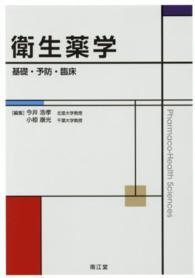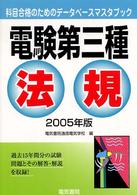基本説明
Covering strategies for nine essential components of effective reading instruction - from fluency to comprehension.
Full Description
"The second edition of Elaine McEwan's book is a user-friendly guide that integrates research into practice. It carefully explains the research behind reading development and provides truly clear, no-nonsense steps to implement the best practices of instruction. McEwan does not sugar-coat how difficult teaching reading can be, but she provides powerful methods for achieving it."
—Jennifer Sandberg, Curriculum/Reading Coordinator
Sutherland Public School, NE
Provide effective reading instruction for every student in your classroom and schoolwide!
To successfully teach reading, teachers have to first believe that all children can learn to read—and then they have to turn that belief into a reality. In this thoroughly updated and revised version of her best-selling book, Elaine K. McEwan guides educators through the challenging but crucial work of teaching every child how to read.
Written for all teachers as well as administrators, this resource covers strategies for nine essential components of effective reading instruction: phonemic awareness, phonics, spelling, fluency, developing a reading culture, providing opportunities to read, writing, word knowledge, and comprehension. This second edition features:
The most up-to-date research in reading instruction
Effective instructional practices and strategies
Brief vignettes and graphic organizers that illustrate and summarize key concepts
A comprehensive case study of one district's remarkable success
This resource reveals precisely how educators in successful schools are teaching students to read—and how all educators can achieve the same results in their schools!
Contents
List of Figures
About the Author
Preface
The Story Behind This Book
How the Reading Puzzle Has Changed
The Meaning of ALL
The Goals of This Book
Who This Book Is For
Overview of the Contents
Program Recommendations
Special Features of the Second Edition
Acknowledgments
Introduction
Shift Your Paradigms
Put Together the Reading Puzzle
Become an Instructional Leader
Summarizing the Introduction
Notes
1. Phonemic Awareness
What Is Phonemic Awareness and How Do Students Acquire It?
When Should Phonemic Awareness Be Taught?
The Role of Phonemic Awareness in Skilled Reading
Scientific Evidence for Phonemic Awareness Instruction
Effective Instructional Practices for Teaching Phonemic Awareness
Guidelines for Implementing Phonemic Awareness Instruction
Summarizing Chapter 1
Notes
2. Phonics
What Is Phonics and How Do Students Learn to Decode?
When Should Phonics Be Taught?
The Role of Phonics in Skilled Reading
Scientific Evidence for Phonics Instruction
Effective Instructional Practices for Teaching Phonics
Summarizing Chapter 2
Notes
3. Spelling
What Is Spelling and How Do Students Become Good Spellers?
When Should Spelling Be Taught?
The Role of Spelling in Skilled Reading
Scientific Evidence for Spelling Instruction
Effective Instructional Practices for Teaching Spelling
Intensive Spelling-Based Reading Interventions
Summarizing Chapter 3
4. Fluency
What Is Fluency and How Do Students Become Fluent Readers?
When Should Fluency Be Taught?
The Role of Fluency in Skilled Reading
Scientific Evidence for Fluency Instruction
Effective Instructional Practices for Facilitating Fluency
Summarizing Chapter 4
5. Word and World Knowledge
What Is Word and World Knowledge and How Do Students Acquire It?
When Should Word and World Knowledge Be Taught?
The Role of Word and World Knowledge in Skilled Reading
Scientific Evidence for Teaching Word and World Knowledge
Effective Instructional Practices for Teaching Word and World Knowledge
Summarizing Chapter 5
6. Comprehension
What Is Comprehension and How Do Students Become Skilled Comprehenders?
When Should Comprehension Be Taught?
The Role of Comprehension in Skilled Reading
Scientific Evidence for Teaching Comprehension
Effective Instructional Practices for Teaching Comprehension
Take Comprehension Instruction to the Next Level
Summarizing Chapter 6
7. Reading a Lot
What Is Reading a Lot and How Do Student Become Voracious Readers?
When Should Reading a Lot Be Taught?
The Role of Reading a Lot in Skilled Reading
The Lack of Scientific Evidence for Reading a Lot
Effective Instructional Practices for Teaching Reading a Lot
Summarizing Chapter 7
8. Writing
What Is Writing and How Do Students Learn to Write?
When Should Writing Be Taught?
The Relationship of Reading and Writing
Scientific Evidence for the Writing-Reading Connection
Notching Up Reading and Writing Instruction
Summarizing Chapter 8
9. A Reading Culture
Welcome to Gering
The Gering "No Excuses" Model
Paradigms
Academic Focus
Curriculum, Instruction, and Assessment
Grouping and Time
Professional Development
Expectations
Sustainability Beyond NIFDI and RF
Summarizing Chapter 9
References
Index







